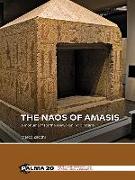- Start
- The naos of Amasis
The naos of Amasis
Angebote / Angebote:
The naos AM 107 of the Museum of Antiquities in Leiden was made by order of king Amasis in the 6th century BC, a period that saw an intense production of monolithic shrines. Despite its unimpressive dimensions, the naos of Leiden stands out for its originality. What is particularly interesting about this monument is that its distinctiveness is strictly connected to the nature of its recipient. Amasis dedicated the naos to Osiris Hemag, one of the most important and enigmatic Osirian forms of the first millennium BC. Osiris Hemag represents Osiris at a crucial moment of his existence: his reawakening. It was precisely this aspect of the god that strongly influenced both the shape and the decoration of the naos, creating a unique effect. Indeed, this is the only Egyptian naos showing on its surfaces groups of guardian-deities who had the task to protect the body of Osiris and to assist him in his rebirth and rejuvenation. This naos is not only a shrine housing a statue of Osiris Hemag, but also a monument conveying a new definition of the god and new ideas concerning his rebirth. Contents PREFACELIST OF FIGURESABBREVIATIONSBIBLIOGRAPHY I NAOS AM 107: FROM EGYPT TO LEIDEN II DESCRIPTION OF THE NAOS1. The architecture2. The decoration3. Some palaeographic and stylistic observations III THE NAOI OF AMASIS1. The naoi2. The damnatio memoriae3. The decorations4. The recipients: Osiris and the others IV THE ROLE OF THE NAOS1. The recipient of the naos: Osiris Hemag2. The dedicatory text3. Great gods, small gods: divine beings in action4. Naoi at Kom el-Ahmar Indices1 Deities2 Deities (in transliteration)3 Royal names4 Egyptian personal names5 Names of buildings and places6 Museum Collections
Folgt in ca. 10 Arbeitstagen
